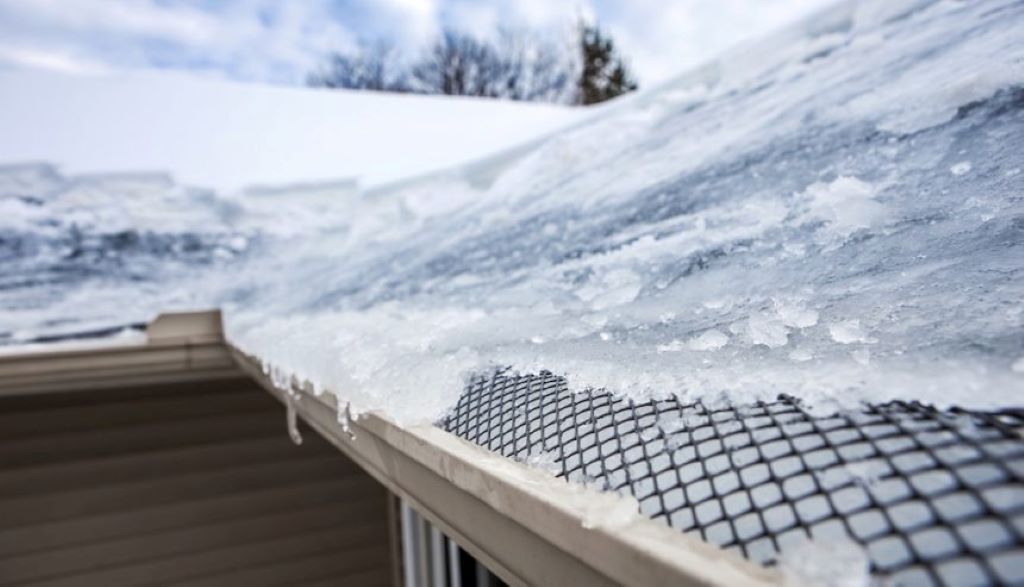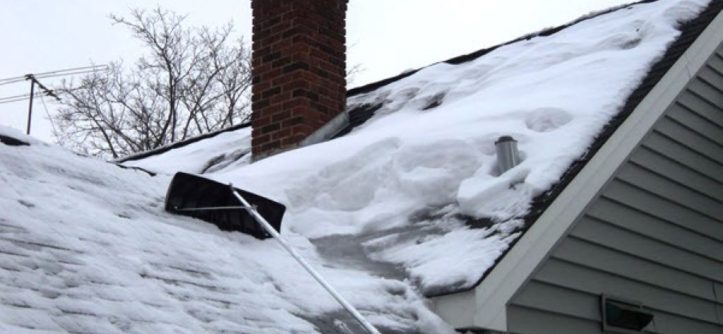Winter in cold climates brings a cozy charm with snow-covered roofs, but it also introduces a hidden menace: ice dams. These ridges of ice that form along roof edges can wreak havoc on your home, causing leaks, structural damage, and costly repairs. Ice dam prevention for cold climates is not just about reacting to problems; it’s about outsmarting winter’s worst. As a homeowner who’s weathered many snowy seasons, I’ve seen the damage ice dams can cause and learned the hard-won lessons of prevention. This article dives deep into the science, solutions, and strategies to keep your home safe, drawing on expert insights, real-world data, and practical tips to ensure your roof stands strong against the freeze-thaw cycle.
Understanding Ice Dams: The Science Behind the Problem
What Are Ice Dams?
Ice dams form when snow on a roof melts due to heat escaping from the home, only to refreeze at the colder eaves. This creates a barrier that traps subsequent meltwater, which can seep under shingles and into your home. According to the University of Minnesota Extension, ice dams require three conditions: snow on the roof, roof temperatures above 32°F in higher areas, and below 32°F at the eaves. This temperature differential is the root cause, driven by heat loss from the house.
Why Are Ice Dams a Concern?
The damage from ice dams is both immediate and long-term. The Insurance Institute for Business & Home Safety (IBHS) reports that ice dams can cause water to infiltrate attics, leading to mold growth, damaged insulation, and compromised structural integrity. A single severe ice dam can result in repair costs ranging from $5,000 to $20,000, depending on the extent of water damage. Beyond financial costs, there’s the risk of icicles falling, posing a safety hazard. A 2023 study by the National Association of Home Builders noted that 60% of homes in northern climates experience some form of ice dam-related damage over a decade.
The Role of Cold Climates
Cold climates amplify ice dam risks due to heavy snowfall and prolonged freezing temperatures. In regions like the Northeast or Midwest, where ground snow loads often exceed 30 pounds per square foot, the insulating effect of snow traps heat, exacerbating melting. The logic here is simple: more snow means more insulation, which keeps the roof warmer and increases meltwater production. This makes proactive prevention critical.
Reference: University of Minnesota Extension, “Dealing with and Preventing Ice Dams”; IBHS, “Ice Dam Prevention Recommendations”.
Root Causes of Ice Dams: Why Your Roof Is at Risk
Heat Loss from the Home
The primary driver of ice dams is heat escaping from living spaces into the attic. This heat, often from inadequate insulation or air leaks, warms the roof unevenly. For example, a 2024 article from This Old House explains that heat travels via conduction, convection, and radiation, with convection through air leaks being a major culprit. Poorly sealed attic hatches, recessed lights, or HVAC ducts can leak warm air, raising attic temperatures above freezing.
Counterpoint: Some argue that external factors like solar radiation contribute significantly. While sunlight can warm dark-colored roofs, experts like Dan Parker from J.S. Held note that internal heat loss is the dominant factor in 90% of ice dam cases, as solar heat is minimal in winter’s short daylight hours.
Inadequate Insulation
Insulation acts as a thermal barrier, keeping heat inside the home. The U.S. Department of Energy recommends an R-value of 38 to 60 for attics in cold climates, yet a 2022 survey by the Building Performance Institute found that 90% of U.S. homes are under-insulated. Insufficient insulation allows heat to reach the roof, melting snow. For instance, 12 inches of fiberglass batt insulation provides roughly R-38, but older homes often have half that.
Counterpoint: Some homeowners believe adding more insulation alone solves the problem. However, without addressing air leaks, insulation’s effectiveness is limited, as warm air can bypass it through gaps.
Poor Attic Ventilation
Ventilation keeps attic temperatures close to outdoor conditions, preventing snow melt. A well-ventilated attic requires one square foot of vent opening per 300 square feet of attic floor, per the International Residential Code (IRC). Blocked soffit vents or inadequate ridge vents disrupt airflow, trapping warm air. A 2021 study by the Building America Solution Center found that homes with poor ventilation were 70% more likely to develop ice dams.
Counterpoint: Some argue ventilation is overrated, as sealing air leaks and adding insulation are more effective. While sealing and insulation are critical, ventilation complements these by removing residual heat, making it a vital layer of defense.
Reference: This Old House, “How to Get Rid of Ice Dams”; Building America Solution Center, “Construct Roofs and Attics for Ice Dam Prevention”.
Proactive Prevention Strategies: Building a Resilient Roof
Insulate Like a Pro
Upgrading attic insulation is a cornerstone of ice dam prevention. Aim for an R-value of 38 to 60, depending on your climate zone. For example, in Climate Zone 6 (e.g., Minnesota), R-49 is the minimum per the 2018 IRC. Use materials like cellulose or closed-cell spray foam, which also act as air barriers. A 2023 report by the National Renewable Energy Laboratory showed that homes with R-49 insulation reduced heat loss by 40%, significantly lowering ice dam risks.
Practical Tip: Check your insulation’s condition. If it’s compacted or wet, replace it, as wet insulation loses up to 50% of its R-value. Hire a professional to assess insulation levels and ensure even coverage, especially at the eaves where space is tight.
Seal Air Leaks
Air leaks are the silent saboteurs of ice dam prevention. Common culprits include attic hatches, recessed lights, and ductwork. Use spray foam or caulk to seal gaps, and install weather-stripped caps on attic hatches. A 2022 Fine Homebuilding article recommends using foil-faced foam board for hatches, secured with aluminum tape. This can reduce air leakage by up to 80%, per blower door tests.
Practical Tip: Conduct a visual inspection or hire an energy auditor with a thermal camera to pinpoint leaks. Focus on areas around chimneys, vents, and electrical penetrations.

Optimize Attic Ventilation
Install a combination of soffit and ridge vents to create continuous airflow. Ensure vents are clear of debris and insulation, using baffles to maintain airflow paths. A 2023 DECRA Metal Roofing guide emphasizes that proper ventilation can reduce attic temperatures by 10-15°F, preventing snow melt. For steep roofs, consider power vents to boost airflow.
Practical Tip: Check vent openings annually. A clogged soffit vent can reduce airflow by 50%, negating ventilation benefits. If retrofitting, consult a roofing contractor to balance vent sizes with attic dimensions.
Consider Metal Roofing
Metal roofs, especially those with steep slopes, shed snow more effectively, reducing ice dam formation. A 2025 article by Classic Metal Roofs notes that metal roofs can last over 100 years and withstand heavy snow loads. Their smooth surfaces and reflective coatings minimize heat retention. However, they’re not foolproof; insulation and ventilation remain critical.
Counterpoint: Some argue metal roofs are too expensive, with installation costs 20-30% higher than asphalt shingles. However, their durability and energy efficiency can offset costs over time, with savings of up to $500 annually on heating bills.
Reference: Fine Homebuilding, “Preventing Ice Dams”; Classic Metal Roofs, “Ice Dams and How to Avoid Potential Damage”.
Immediate Actions for Ice Dam Mitigation
Safe Snow Removal
Removing snow from the roof’s edge prevents the raw material for ice dams. Use a long-handled roof rake with wheels to avoid shingle damage. A 2024 SERVPRO article suggests clearing 3-4 feet from the eaves after heavy snowfalls. This reduces snow’s insulating effect, which can increase roof temperatures by 5-10°F per inch of snow.
Safety Note: Never climb onto a snowy roof. Falling injuries are a leading cause of winter-related hospitalizations, with over 15,000 cases annually, per the CDC.
Temporary Fixes for Active Ice Dams
If an ice dam forms, act quickly to minimize damage. One method is to use a box fan in the attic to blow cold air at the leak point, freezing the water temporarily, as suggested by This Old House. Another is to fill nylon stockings with calcium chloride ice melt and place them across the dam to create drainage channels. Avoid chipping ice, as this can damage shingles and void warranties.
Counterpoint: Some homeowners use heat cables as a quick fix. While effective, a 2023 Spruce article warns that improper installation poses fire risks, and cables don’t address underlying insulation issues.
Professional Intervention
For severe ice dams, hire a roofing contractor. They use steamers to melt ice safely without damaging the roof. A 2024 GAF article notes that professionals can also install water-repellent membranes during repairs, reducing future leak risks by 90%.
Reference: SERVPRO, “Ice Dams Can Cause Significant Damage”; GAF, “4 Ice Dam Prevention Tips for Winter”.
Long-Term Investments for Ice Dam-Free Winters
Install a Water-Repellent Membrane
When reroofing, add a self-adhering waterproof underlayment from the eaves to 3 feet above the exterior wall plane. This acts as a barrier against water infiltration, per Fine Homebuilding. In regions with heavy snow loads (>60 lb/ft²), extend the membrane further. This can reduce leak damage by up to 95%, according to a 2021 Building America study.
Upgrade to a Vented Roof Design
For new construction or major renovations, consider a vented compact roof with insulation above the deck and a ventilation gap. This design, detailed in a 2023 SGH article, keeps the roof deck consistently cold, reducing ice dam risks by 80% in high-snow areas.
Regular Maintenance and Inspections
Annual roof inspections catch potential issues like clogged vents or damaged shingles. A 2025 GNMC article recommends bi-annual checks for metal roofs to ensure coatings and snow guards are intact. Clean gutters before winter to prevent ice buildup, which can exacerbate dams.
Reference: SGH, “Ice Dams: What You Should Know”; GNMC, “Ice Damming 101”.
FAQs About Ice Dam Prevention
Q: Can metal roofs completely prevent ice dams?
A: Metal roofs reduce ice dam risks by shedding snow, but they’re not immune. Proper insulation and ventilation are still essential, as uneven roof temperatures can still cause dams, especially in valleys.
Q: Are heat cables a long-term solution?
A: Heat cables are a temporary fix. They prevent refreezing but don’t address heat loss. Long-term solutions like insulation and ventilation are more effective and energy-efficient.
Q: How much insulation is enough?
A: In cold climates, aim for R-38 to R-60 in the attic, per the U.S. Department of Energy. Check local codes, as requirements vary by climate zone.
Q: Is it safe to remove snow myself?
A: Use a roof rake from the ground to stay safe. Climbing onto a snowy roof is dangerous, with a high risk of falls. Hire professionals for large or multi-story homes.
Conclusion: Arm Your Home Against Ice Dams
Ice dam prevention for cold climates is about preparation, not reaction. By understanding the science—heat loss, insulation, and ventilation—you can protect your home from winter’s wrath. Insulate your attic to R-38 or higher, seal air leaks, and ensure proper ventilation to keep your roof cold. For immediate threats, use roof rakes or professional services, but invest in long-term solutions like metal roofing or waterproof membranes for lasting peace of mind. With these strategies, you’ll not only save thousands in repairs but also enjoy a warmer, more energy-efficient home. Winter may be relentless, but your roof can be ready.
Read More:
Maximizing Your Septic System’s Efficiency
How to Lower Your Electric Bill: Effective Ways to Save Energy




